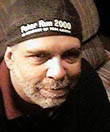|
|
This topic comprises 2 pages: 1 2
|
|
Author
|
Topic: Why not build onto the platter?
|
|
|
|
|
|
|
|
|
|
|
|
|
Scott Norwood
Film God

Posts: 8146
From: Boston, MA. USA (1774.21 miles northeast of Dallas)
Registered: Jun 99
|
 posted 10-26-1999 08:51 PM
posted 10-26-1999 08:51 PM





Maybe I'm totally nuts, but I must say that I personally prefer to do print inspection on a handcrank rewind bench if the print isn't in great condition. I think that it's easier on the film than constantly starting and stopping a motorized rewind bench, and it allows more thorough inspection of the film. Then again, I've never had the luxury of a variable-speed motorized rewind bench, which would probably be ideal for print inspection. Do "modern" booths even have handcrank rewind benches?
Although I've never worked with platters, I will say that I like to have a bunch of items on the rewind bench when inspecting a print; this stuff would never fit on the makeup tables that I've seen. A sync block is absolutely essential when making up trailer reels, since many trailers don't have framelines printed at the fade-in of the green/red band and at the fade-out of the credits at the end. A sync block is also a "must" when dealing with credits or dark scenes which are excessively splicy. I also like to have two different splicers--one with clear tape and one with zebra tape. I normally use clear tape exclusively, but the zebra tape is good for marking reel changes with prints that are exceptionally splicy.
A tape dispenser with artists' tape or painters' masking tape is important, too, since I use tape to hold coiled-up head and tail leaders for prints that don't come with reel bands. Other stuff that I like to have at the rewind bench: rack of common house trailers ("Dolby", "Concession Stand", "Feature Presentation", "Coming Soon", Academy countdowns, etc.); split reels; scissors (for cutting out large chunks of damaged footage); Sharpies (for labelling heads/tails and large reels); and other stuff that I can't think of right now.
| IP: Logged
|
|
|
|
Scott Ribbens
Expert Film Handler
Posts: 118
From: Los Angeles
Registered: Oct 1999
|
 posted 10-27-1999 01:01 AM
posted 10-27-1999 01:01 AM




I agree, it's a time/money thing. The 16 plex that I once worked at, I did all of the film work myself. Thursday I had nine hours to do my payroll, build up all trailer packs for new movies, get the trailers together for all of the prints that were staying in the complex and needed trailer changes, tear down all of the prints that were leaving, build up all of the prints for Firday(we had a standing order to get all prints in on Thursday), move all of the prints that were changing auditoriums, and move up 12 digital processors/digital sound heads. Friday morning I would do all of the trailer changes, and break down trailer packs! I just did not have the time,(nor do most others, I think) to inspect all of the prints coming into the building. I would have liked to do it, but it just wasn't feasible. I would have liked to screen each print too!! By the way, did you know that AMC policy is that all prints are screened before they are shown to the public!! (I never worked there, but there was one up the street from a theatre that I used to work at.)
| IP: Logged
|
|
|
|
|
|
|
|
|
|
|
|
|
|
|
|
All times are Central (GMT -6:00)
|
This topic comprises 2 pages: 1 2
|
Powered by Infopop Corporation
UBB.classicTM
6.3.1.2
The Film-Tech Forums are designed for various members related to the cinema industry to express their opinions, viewpoints and testimonials on various products, services and events based upon speculation, personal knowledge and factual information through use, therefore all views represented here allow no liability upon the publishers of this web site and the owners of said views assume no liability for any ill will resulting from these postings. The posts made here are for educational as well as entertainment purposes and as such anyone viewing this portion of the website must accept these views as statements of the author of that opinion
and agrees to release the authors from any and all liability.
|

 Home
Home
 Products
Products
 Store
Store
 Forum
Forum
 Warehouse
Warehouse
 Contact Us
Contact Us




 Printer-friendly view of this topic
Printer-friendly view of this topic















